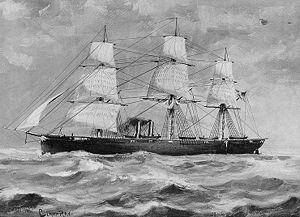USS Niagara (1855)

| |
| Career | 100x35px |
|---|---|
| Name: | USS Niagara |
| Builder: | New York Navy Yard |
| Launched: | 23 February 1855 |
| Commissioned: | 6 April 1857 |
| Decommissioned: | 28 September 1864 |
| Fate: | Sold, 6 May 1885 |
| General characteristics | |
| Type: | Steam frigate |
| Displacement: | 5,540 long tons (5,629 t) |
| Length: | 328 ft 10 in (100.23 m) |
| Beam: | 55 ft 4 in (16.87 m) |
| Draft: | 24 ft 5 in (7.44 m) |
| Propulsion: | Sails / Steam engine |
| Complement: | 251 |
| Armament: | 12 × 11 in (280 mm) Dahlgren smoothbore guns |
The second USS Niagara was a steam frigate in the United States Navy.
Niagara was launched by New York Navy Yard on 23 February 1855; sponsored by Miss Annie C. O'Donnell; and commissioned on 6 April 1857, Captain William L. Hudson in command.
Contents
Service history
Transatlantic telegraph cable, 1857–1858
Niagara sailed from New York on 22 April 1857 for England, arriving Gravesend on 14 May. A log of the ship's voyage across the Atlantic[1] was kept by the correspondent of the New York Daily Times, where it was published on Thursday, 14 May 1857. On arrival in England Niagara was equipped to lay cable for the first transatlantic telegraph, which was to follow the shallow tableland discovered between Newfoundland and Ireland by Matthew F. Maury. By 11 August, when a break in the cable defied recovery, she had laid several hundred miles westward from Valentia Island, Ireland. She returned to New York 20 November and decommissioned 2 December to prepare for a second essay at cable-laying. Recommissioning 24 February 1858, Captain William L. Hudson in command, she sailed 8 March, arrived Plymouth, England, 28 March, and experimented with HMS Agamemnon. The ships returned to Plymouth to fit out, then made a mid-ocean rendezvous on 29 July, spliced their cable ends, and each sailed toward her own continent. On 5 August, Niagara's boats carried the end of the cable ashore at Brills Mouth Island, Newfoundland, and the same day Agamemnon landed her end of the cable. The first message flashed across 16 August, when Queen Victoria sent a cable to President James Buchanan. This first cable operated for three weeks; ultimate success came in 1866.
Voyage to Africa, 1858
Niagara's next mission was the carrying of 200 Africans, liberated from slave brig Echo off Cuba by the brig Dolphin on 21 August, to Liberia. She sailed with them from Charleston, South Carolina on 20 September, reached Monrovia on 9 November, and returned to New York on 11 December, decommissioning there on 17 December 1858.
Voyage to Japan, 1860–1861
Niagara recommissioned on 14 May 1860, Captain William McKean in command. Another unique assignment awaited; she was to carry Japan's first diplomatic mission to the United States from Washington to New York, and then home. Leaving New York on 30 June, Niagara called in Porto Grande, Cape Verde Islands; São Paulo-de-Loande (now Luanda), Angola; Batavia (now Djakarta), Java; and Hong Kong. The frigate entered Tokyo Bay on 8 November to land her distinguished passengers, then sailed on 27 November for Hong Kong, Aden, and Cape Town, returning Boston on 23 April 1861 to learn of the outbreak of the Civil War.
Civil War, 1861–1864
Quickly preparing for duty on the blockade of southern ports, Niagara arrived off Charleston, South Carolina on 10 May, and two days later captured blockade runner General Parkhill attempting to make Charleston from Liverpool. Through the summer she gave similar service at Mobile Bay, and was at Fort Pickens, Florida on 22 September when Flag Officer William McKean in Niagara took command of the East Gulf Blockading Squadron. She engaged Confederate defenses at Fort McRee, Pensacola, and Warrington on 22 November, and was hulled twice above the waterline. On 5 June 1862 she sailed for repairs at Boston Navy Yard, where she decommissioned 16 June. Recommissioned 14 October 1863, Niagara steamed from New York on 1 June 1864 to watch over Confederate warships then fitting out in Europe. She reached her base at Antwerp on 26 June, and from there roved the English Channel, the French Atlantic Coast and the Bay of Biscay. On 15 August she took steamer Georgia, a former Confederate warship, off Portugal. In February and March, with Sacramento she lay at Ferrol, Spain, to prevent Confederate ironclad Stonewall from departing, but the much more powerful southern ship was able to make good her escape.
Niagara patrolled with the European Squadron until 29 August when she cleared Cadiz for Boston, arriving on 20 September. There she decommissioned on 28 September 1864, remaining in the Boston Navy Yard until sold on 6 May 1885.
References
This article includes text from the public domain Dictionary of American Naval Fighting Ships. The entry can be found here.
- Pages with broken file links
- Wikipedia articles incorporating text from the Dictionary of American Naval Fighting Ships
- Sailing frigates of the United States Navy
- Ships of the Union Navy
- Ships built in New York
- Gunboats of the United States Navy
- American Civil War patrol vessels of the United States
- United States Navy steamships
- United States Navy New York-related ships
- 1855 ships
- Cable ships of the United States Navy
